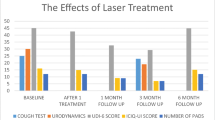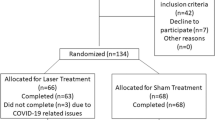Abstract
Introduction and hypothesis
Female stress urinary incontinence (SUI) is a prevalent condition, and conservative treatment options are needed. Were evaluated CO2 laser and radiofrequency as treatment for SUI.
Methods
One hundred thirty-nine women with SUI were eligible and randomized in a three-arm double-blind randomized controlled trial into radiofrequency (RF), laser (LS) and sham control (SCT) groups, with 3-monthly outpatient treatment sessions. One hundred fourteen women were included, 38 in each group, during a 12-month follow-up.
The primary outcomes were: subjective improvement of SUI, evaluated on a Likert scale, and objective cure, which was a composite outcome defined according to negative stress tests, voiding diary and pad test. Questionnaires were also applied. The sample size was calculated to provide 80% power to identify a 20% difference between groups, p < 0.05.
Results
Subjective improvement and objective cure of SUI were identified respectively in 72.6% and 45.2% in LS and in 61.7% and 44.7% in RF, both significantly higher than the 30.0% and 14.0% in SCT. Considering only mild cases (pad test < 10 g), objective cure was achieved in 66.7% in LS, 63.6% in RF and 22.2% in SCT. Significant reduction in the number of episodes of urinary incontinence was found according to voiding diaries (p = 0.029) and pad weight (p = 0.021). A significant reduction in urgency and urinary loss during sexual intercourse was observed only with LS and RF. Improvement in quality of life was also verified by the I-QoL and ICIQ-SF in favor of the energy-treated groups.
Conclusions
CO2 laser and radiofrequency are outpatient options for SUI treatment, with no major complications. They had similar results and presented better results than in the sham control group.


Similar content being viewed by others
References
MacLennan AH, Taylor AW, Wilson DH, Wilson D. The prevalence of pelvic floor disorders and their relationship to gender, age, parity and mode of delivery. BJOG. 2000;107:1460–70. https://doi.org/10.1111/j.1471-0528.2000.tb11669.x.
Devore EE, Minassian VA, Grodstein F. Factors associated with persistent urinary incontinence. Am J Obstet Gynecol. 2013;209:145.e1–6. https://doi.org/10.1016/j.ajog.2013.05.002.
Haylen BT, de Ridder D, Freeman RM, et al. An International Urogynecological Association (IUGA)/International Continence Society (ICS) joint report on the terminology for female pelvic floor dysfunction. IntUrogynecol J. 2010;21:5–26. https://doi.org/10.1007/s00192-009-0976-9.
Cavkaytar S, Kokanali MK, Topcu HO, Aksakal OS, Doðanay M. Effect of home-based Kegel exercises on quality of life in women with stress and mixed urinary incontinence. J Obst Gynaecol. 2015;35:407–10. https://doi.org/10.3109/01443615.2014.960831.
Schimpf MO, Rahn DD, Wheeler TL, et al. Sling surgery for stress urinary incontinence in women: a systematic review and meta-analysis. Am J Obstet Gynecol. 2014;211(71):e1–27. https://doi.org/10.1016/j.ajog.2014.01.030.
Chang J, Lee D. Midurethral slings in the mesh litigation era. Transl Androl Urol. 2017;6(Suppl 2):S68–75. https://doi.org/10.21037/tau.2017.04.06.
Salvatore S, Leone RMU, Athanasiou S, et al. Histological study on the effects of microablative fractional CO2 laser on atrophic vaginal tissue: an ex vivo study. Menopause. 2015;22:845–9. https://doi.org/10.1097/GME.0000000000000401.
Cruz VL, Steiner ML, Pompei LM, et al. Randomized, double-blind, placebo-controlled clinical trial for evaluating the efficacy of fractional CO2 laser compared with topical estriol in the treatment of vaginal atrophy in postmenopausal women. Menopause. 2018;25:21–8. https://doi.org/10.1097/GME.0000000000000955.
Okui N. Comparison between erbium-doped yttrium aluminum garnet laser therapy and sling procedures in the treatment of stress and mixed urinary incontinence. World J Urol. 2019;37(5):885–9. https://doi.org/10.1007/s00345-018-2445-x.
Fistonić N, Fistonić I, Lukanovič A, et al. First assessment of short-term efficacy of Er:YAG laser treatment on stress urinary incontinence in women: prospective cohort study. Climacteric. 2015;18(1):37–42. https://doi.org/10.3109/13697137.2015.1071126.
Dillon B, Dmochowski R. Radiofrequency for the treatment of stress urinary incontinence in women. Current Urology Reports . 2009;10(5):369–374. https://doi.org/10.1007/s11934-009-0058-z.
Kamilos MK, Borrelli CL. New therapeutic option in genitourinary syndrome of menopause: pilot study using microablative fractional radiofrequency. Einstein J. 2017;15:445–51. https://doi.org/10.1590/s1679-45082017ao4051.
Juszczak E, Altman DG, Hopewell S, Schulz K. Reporting of multi-arm parallel-group randomized trials: extension of the CONSORT 2010 statement. JAMA. 2019;321(16):1610–20. https://doi.org/10.1001/jama.2019.3087.
Souza CCC, Rodrigues AM, Ferreira CE, et al. Portuguese validation of the urinary incontinence-specific quality-of-life instrument: I-QOL. Int Urogynecol J. 2009;20(10):1183–9. https://doi.org/10.1007/s00192-009-0916-8.
Tamanini JTN, Dambros M, D'Ancona CAL, Palma PCR, Netto NR Jr. Validation of the “international consultation on incontinence questionnaire - short form” (ICIQ-SF) for Portuguese. Rev Saude Publica. 2004;38(3):438–44. https://doi.org/10.1590/S0034-89102004000300015.
Thiel RDRC, Dambros M, Palma PCR, Thiel M, Riccetto CLZ, Ramos MDF. Translation into Portuguese, cross-national adaptation and validation of the female sexual function index. Rev Bras Ginecol e Obstet. 2008;30(10):504–10. https://doi.org/10.1590/S0100-72032008001000005.
Conté C, Jauffret T, Vieillefosse S, Hermieu JF, Deffieux X. Laser procedure for female urinary stress incontinence: a review of the literature. Prog Urol. 2017;27(17):1076–83. https://doi.org/10.1016/j.purol.2017.09.003.
FDA warns against use of energy-based devices to perform vaginal ‘rejuvenation’ or vaginal cosmetic procedures: FDA Safety Communication. https://www.fda.gov/MedicalDevices/Safety/AlertsandNotices/ucm615013.htm. Accessed 30 July 2018.
Preti M, Vieira-Baptista P, Digesu GA, et al. The clinical role of LASER for vulvar and vaginal treatments in gynecology and female urology: an ICS/ISSVD best practice consensus document. Neurourol Urodyn. 2019;38(3):1009–23. https://doi.org/10.1002/nau.23931.
Digesu GA, Tailor V, Preti M, et al. The energy based devices for vaginal "rejuvenation," urinary incontinence, vaginal cosmetic procedures, and other vulvo-vaginal disorders: an international multidisciplinary expert panel opinion. Neurourol Urodyn. 2019;38(3):1005–8. https://doi.org/10.1002/nau.23927.
Shobeiri SA, Kerkhof MH, Minassian VA, Bazi T. IUGA Research and Development Committee. IUGA committee opinion: laser-based vaginal devices for treatment of stress urinary incontinence, genitourinary syndrome of menopause, and vaginal laxity. Int Urogynecol J. 2019;30(3):371–6. https://doi.org/10.1007/s00192-018-3830-0.
Escribano JJ, González-Isaza P, Tserotas K, et al. In response to the FDA warning about the use of photomedicine in gynecology. Lasers Med Sci. 2019;34(7):1509–11. https://doi.org/10.1007/s10103-019-02744-1.
Salvatore S, Athanasious S, Yuen HTH, Karram M. LASER users' expert opinion in response to "the clinical role of LASER for vulvar and vaginal treatments in gynecology and female urology: an ICS/ISSVD best practice consensus document". Neurourol Urodyn. 2019;38(8):2383–4. https://doi.org/10.1002/nau.24140.
Pace G, Vicentini C. Female sexual function evaluation of the tension-free vaginal tape (TVT) and transobturator suburethral tape (TOT) incontinence surgery: results of a prospective study. J Sex Med. 2008;5(2):387–93. https://doi.org/10.1111/j.1743-6109.2007.00708.x.
Jha S, Radley S, Farkas A, Jones G. The impact of TVT on sexual function. Int Urogynecol J Pelvic Floor Dysfunct. 2009;20(2):165–9. https://doi.org/10.1007/s00192-008-0743-3.
El-Azab AS, Yousef HA, Seifeldein GS. Coital incontinence: relation to detrusor overactivity and stress incontinence. Neurourol Urodyn. 2011;30(4):520–4. https://doi.org/10.1002/nau.21041.
Gray T, Li W, Campbell P, Jha S, Radley S. Evaluation of coital incontinence by electronic questionnaire: prevalence, associations and outcomes in women attending a urogynaecology clinic. Int Urogynecol J. 2018;29(7):969–78. https://doi.org/10.1007/s00192-017-3380-x.
Acknowledgments
This study received funding from CAPES (Coordenação de Aperfeiçoamento de Pessoal de Nível Superior, a Brazilian Federal Agency, linked to the Ministry of Education) and Process 2019/15802-1, FAPESP (Fundação de Amparo à Pesquisa do Estado de São Paulo, a public institution to promote academic research linked to the São Paulo State Government). Thanks to the Sector of Urogynecology and Vaginal Surgery, Federal University of São Paulo.
Author information
Authors and Affiliations
Contributions
AS Seki: Project development, Data collection, Data analysis, Manuscript writing.
AMHMB Ferraro: Project Development, Data analysis, Manuscript writing/editing.
ESM Fonseca: Data collection.
MGF Sartori: Project development, Manuscript editing.
MJBC Girão: Project development, Data analysis.
ZIKJD Bella: Project development, Data analysis, Manuscript writing/editing.
Corresponding author
Ethics declarations
Conflicts of interest
None.
Additional information
Publisher’s note
Springer Nature remains neutral with regard to jurisdictional claims in published maps and institutional affiliations.
Manoel J. B. C. Girão (in memoriam)
The preliminary results of this study were presented previously at the 58th Brazilian Congress of Gynecology and Obstetrics in Porto Alegre, Brazil (November 2019), and the paper received an awarded as an original study. It was also selected as an oral presentation at the 45th IUGA Annual Meeting (virtual), August/September 2020. In 2021, this study was presented and received first prize at the 26th Paulista Congress of Gynecology and Obstetrics in São Paulo (SOGESP).
Rights and permissions
About this article
Cite this article
Seki, A.S., Bianchi-Ferraro, A.M.H.M., Fonseca, E.S.M. et al. CO2 Laser and radiofrequency compared to a sham control group in treatment of stress urinary incontinence (LARF study arm 3). A randomized controlled trial. Int Urogynecol J 33, 3535–3542 (2022). https://doi.org/10.1007/s00192-022-05091-y
Received:
Accepted:
Published:
Issue Date:
DOI: https://doi.org/10.1007/s00192-022-05091-y




